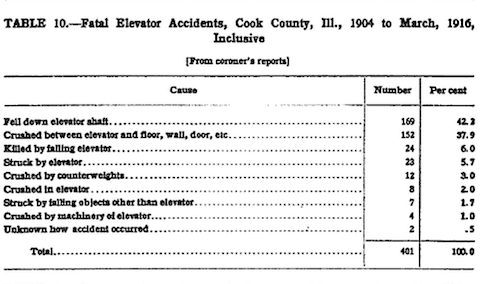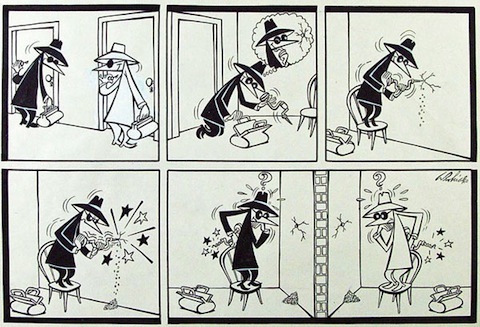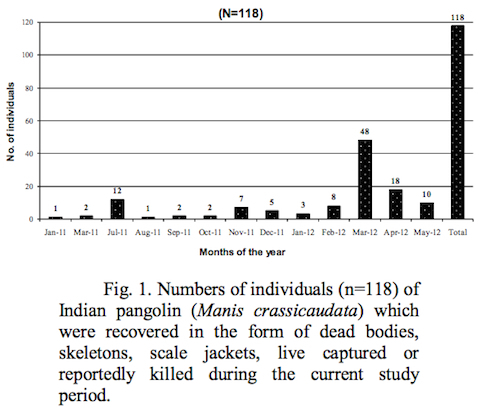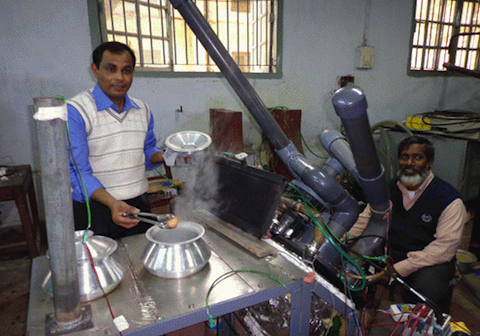Brendan I. Koerner's Blog, page 9
January 18, 2013
Be Thankful for What You’ve Got
 A bundle of statistics to chew over the next time you set foot in an automated elevator. Yes, the steel boxes of today lack a certain charm compared to the ornate, manually-controlled brass contraptions of yore. But at least they’re not death traps. (Current accident statistics here.) Humans are great at many things, but reliable elevator operation is not one of them.
A bundle of statistics to chew over the next time you set foot in an automated elevator. Yes, the steel boxes of today lack a certain charm compared to the ornate, manually-controlled brass contraptions of yore. But at least they’re not death traps. (Current accident statistics here.) Humans are great at many things, but reliable elevator operation is not one of them.
January 17, 2013
A Serious Approach
 If you pay the slightest bit of attention to high-profile criminal cases, you have doubtless encountered the sketches of Harvey Pratt. The Oklahoma-based forensic artist is one of the masters of his craft, and thus a frequent attendee at trials where cameras are verboten. He is also a pioneer of post-mortem reconstruction techniques, which allow police to envision what severely traumatized homicide victims looked like prior to meeting their unfortunate ends.
If you pay the slightest bit of attention to high-profile criminal cases, you have doubtless encountered the sketches of Harvey Pratt. The Oklahoma-based forensic artist is one of the masters of his craft, and thus a frequent attendee at trials where cameras are verboten. He is also a pioneer of post-mortem reconstruction techniques, which allow police to envision what severely traumatized homicide victims looked like prior to meeting their unfortunate ends.
Pratt’s curiosity is not confined to the grisly, however: He is also the most serious-minded Bigfoot artist you’ll ever encounter. In attempting to shed light on the mythical creatures that allegedly stalk North America’s forest, Pratt deals with primary sources no differently than he would for his day job:
The North America Bigfoot Search has brought together years of law enforcement investigative experience and forensic artistry to the field of Bigfoot studies with it’s new book The Hoopa Project: Bigfoot Encounters in California. The Executive Director of North America Bigfoot Search, Dave Paulides has spent the last three years researching and working in the far northern portion of California’s Humboldt County, concentrating in the area of the Hoopa Valley Indian Tribe jurisdiction.
For this project, Harvey Pratt was commissioned to meet with witnesses who saw a Sasquatch and complete forensic sketches based on his interview with them. He met with 13 witnesses and completed 16 forensic sketches that are featured in The Hoopa Project. The drawings bring forth the surprising conclusion that Bigfoot’s facial features appear to be more human than originally thought.
A full gallery of Pratt’s Bigfoot-related work here. I am particularly fond of the perspective on “Researcher’s Last View,” as well as the sheer excess of “My Dark Passenger.”
January 15, 2013
Someone Take Him Up on This
 Belarusian dictator Alexander Lukashenko, who we prefer to think of as The Armed Clown, has a famously high opinion of his own athletic prowess. Today that hubris led him to make a proposition that I hope he will live to regret, as he wrote a check with his mouth that his body surely cannot cash. In the midst of a press conference at which he addressed Hugo Chavez’s ailing health, Lukashenko felt the need to emphasize that he is in no danger of relinquishing his “throne.” And as is his wont, he stressed this fact in the most brazen way possible to journalist in attendance:
Belarusian dictator Alexander Lukashenko, who we prefer to think of as The Armed Clown, has a famously high opinion of his own athletic prowess. Today that hubris led him to make a proposition that I hope he will live to regret, as he wrote a check with his mouth that his body surely cannot cash. In the midst of a press conference at which he addressed Hugo Chavez’s ailing health, Lukashenko felt the need to emphasize that he is in no danger of relinquishing his “throne.” And as is his wont, he stressed this fact in the most brazen way possible to journalist in attendance:
If you question my health, please, put on skates, bring a hockey stick or skis and we will try it with you. You are younger than me. If you want, we can do it in front of everyone. 10km race. If you finish first, you will become president by right of health tomorrow.
You have no idea how fondly we wish for this contest to happen. Because at this point, it looks like old-school trial-by-combat is the only way the Belarusian people will get the change in government they so desperately need.
January 11, 2013
The Mouths of Babes
 Given its obviously confrontational nature, it’s a wonder that Shurooq Amin’s series of paintings entitled “It’s a Man’s World” were shown in Kuwait City at all. The exhibition lasted all of three hours before the secret police shut it down, citing complaints that the art was both “anti-Islamic” and “pornographic.” To her great credit, Amin viewed the closure not as a setback, but as inspiration for her next project. She was aided in that process by her young daughter, whose malapropism led to a eureka moment:
Given its obviously confrontational nature, it’s a wonder that Shurooq Amin’s series of paintings entitled “It’s a Man’s World” were shown in Kuwait City at all. The exhibition lasted all of three hours before the secret police shut it down, citing complaints that the art was both “anti-Islamic” and “pornographic.” To her great credit, Amin viewed the closure not as a setback, but as inspiration for her next project. She was aided in that process by her young daughter, whose malapropism led to a eureka moment:
As soon as I recovered from the shutdown of my show, the pain of that, I immediately started working on the next series. It started with the title. My 12 year old daughter heard people talking about my show, so she came up to me and asked: “Mama, what does popcornographic mean?” I asked her why, and she said she heard people say my show was shut down because it was “popcornographic.” Of course I immediately knew what she meant. So it stuck. I thought: “This is perfect!” I decided to use the term against them by using the version my daughter used. This way nobody can censor it. And the series will explore the actual impact of censorship, lack of freedom of expression and all things taboo.
Check out several more paintings from the “It’s a Man’s World” series here.
January 9, 2013
Espionage Made Easy

The Department of Justice rarely indicts people it has no genuine hope of prosecuting, but an exception was recently made in the case of two Chinese nationals, Wan Li Yuan and “Jason Jiang” (true name unknown). The men, who will surely not be foolish enough to travel to these shores again, are alleged to have gotten their hands on some devices manufactured by Lattice Semiconductor—devices that, because they have obvious military applications, are not supposed to be exported without government clearance. What is astounding about the case is the elegance of the subterfuge employed by Yuan and “Jiang,” who took a page out of the con-man playbook by taking advantage of an unsuspecting intermediary. The whole devious plot is outlined in the richly detailed indictment (PDF):
Defendant Wan Li Yuan falsely claimed to be a person named Nicholas Bush, and falsely claimed to be an employee of Company A, a company located in New York. Defendant also falsely claimed that Company A had a website. In reality, defendant was associated with a China-based company called China Wingwish Group Co., Ltd., which was involved in the procurement of dual-use electronic goods…
On or about April 6, 2010, defendant Wan Li Yuan, aka Wanli Yuan, aka Nicholas Bush, aka Nick Bush, aka Tony Yuan, caused a website to be created which falsely indicated that the website belonged to Company A of New York. Much of the design and wording on this fictitious website was copied from the website of a legitimate Canadian company with no connection to or association with defendant or his business or the business of Company A of New York.
Granted, Yuan seemed to build a fake site somewhat more sophisticated than, say the one for Jukt Micronics. But you have to think a simple Google search could have spared everyone a lot of heartache and loss. Simple frauds can be undone by simple measures.
January 8, 2013
The Not-So-Delicate Dance
Scrambling like mad to deal with Wired and book-related duties as the week bleeds toward Humpday. Back tomorrow with something halfway spectacular about Chinese industrial espionage.
January 4, 2013
The Pangolin’s Curse

There are few environmental tragedies I find more puzzling than the decimation of the pangolin, a phenomenon recently covered by notable Microkhan ally Dan Morrison. Like rhino horns, pangolin scales are in high demand in Asian markets, primarily for medicinal and epicurean purposes. Yet there is little evidence that the scales work better than placebos, something that consumers with the means to pay for the commodity should presumably realize. The persistence of these kinds of myths is one of the real head-scratchers of modern human behavior.
Yet even if the masses suddenly came around to the idea that pangolin scales were actually less effective than, say, a couple of aspirin, the animal might not survive for the long-term. That’s beacause, according to this recent study (PDF) from Pakistan, there may be a large secondary market for the scales:
It has also been revealed from local reliable sources that scales of Indian pangolin are transported to two main cities in the country viz., Islamabad and Lahore and it is suspected that these are being used in manufacturing bullet-proof jackets. This seems probable in the scenario of terrorism in the country for the past 10 years where the demand of such jackets must have increased many folds.
I can find absolutely no studies comparing the blast-absorption properties of pangolin armor with those of Kevlar. But I find it incredibly difficult to believe that the natural option would win the day in that match-up.
December 31, 2012
Another 365
I usually spend the day before New Year’s reflecting on the various triumphs and numerous failures of the preceding twelve months. To my chagrin, however, that just isn’t possible this year—the pace of dealing with two kids is more relentless than I had dared imagine prior to the Grand Emprette’s birth. I’ll have to settle for cleaning my desk, paying off some lingering bills, and (if I’m lucky) making a beer run in preparation for that brief, peaceful interlude between Microkhan Jr.’s bedtime and midnight. Hope you have something far more raucous planned to mark the beginning of our next revolution around the Sun. See you back here at midweek.
December 28, 2012
“An Innocent Third Party”
 When we hear about the ill-advised nature of high-speed police pursuits, it’s usually in relation to injuries suffered by pedestrians or occupants of uninvolved vehicles. But Brian Werner, a Nebraska man who was paralyzed in such a chase, was actually a passenger in a car being pursued. He sued the state for damages and was recently awarded $1 million—the maximum allowable under Nebraska law. As the appellate court’s decision makes clear, the case boiled down to whether Werner—who was in possession of methamphetamine at the time—had any culpability at all for the driver’s rash decision to try and evade arrest:
When we hear about the ill-advised nature of high-speed police pursuits, it’s usually in relation to injuries suffered by pedestrians or occupants of uninvolved vehicles. But Brian Werner, a Nebraska man who was paralyzed in such a chase, was actually a passenger in a car being pursued. He sued the state for damages and was recently awarded $1 million—the maximum allowable under Nebraska law. As the appellate court’s decision makes clear, the case boiled down to whether Werner—who was in possession of methamphetamine at the time—had any culpability at all for the driver’s rash decision to try and evade arrest:
Werner testified that he did not encourage Korth to flee from law enforcement and that he had asked Korth to let him out of the car. Werner explained that he had “heard” that Korth had previously fled from law enforcement, that “nothing good was going to come” from being in the car, and that “it just was not going to end good.” The County objected on hearsay grounds to Werner’s testimony about having “heard” of Korth’s prior history of fleeing from law enforcement. The court overruled the objection and admitted Werner’s testimony.
The court found for Werner. It found that law enforcement had engaged in a “vehicular pursuit” of Korth’s car and that the pursuit was a proximate cause of Werner’s injuries. The court also found that under § 13-911, Werner was an “innocent third party.” We have defined an “innocent third party” as “one who has not promoted, provoked, or persuaded the driver to engage in flight from law enforcement personnel and one who is not sought to be apprehended in the fleeing vehicle.” The court found that [Officer] Wemhoff sought to apprehend the driver for suspected driving under the influence and speeding. Because the court determined that Werner was the passenger in the fleeing car—rather than the driver—the court concluded that Wemhoff had not sought to apprehend Werner. And the court determined that Werner had not “promoted, provoked or persuaded” Korth to flee. The court found that Werner was an “innocent third party.”
What I find most striking about this decision is that it seems to run counter to the way that the law determines who qualifies as an accomplice in criminal matters. So many times, unsuspecting people who have driven acquaintances to and from crime scenes have ended up at the defendant’s table—particularly in cases involving drugs. But in this civil matter, the court was clearly more forgiving of Werner’s character flaws.
At least one justice had reservations about this decision, however: In a concurring opinion, he asked the Nebraska legislature to alter its definition of “an innocent third party,” so that men like Werner would no longer be eligible for damages. Ending counterproductive police pursuits would seem like a wiser course of action, though.
December 27, 2012
The Simple Can Be So Difficult

A few days before Christmas, a milestone of sorts was reached at the Bangladesh University of Engineering and Technology: for the first time ever, a few eggs were cooked on a kerosene stove. This was significant not because of the quality of the meal produced, but rather because the stove generated eight watts of electricity while operating—enough to light up a pair of LED lamps. This feat has been a longtime goal of the Score-Stove Project, which aims to create the hardware necessary to convert the excess energy of cooking into usable electricity. Sounds easy enough, but it has proven quite tough to do in a cost-effective manner—the project has a targeted price-point of around $35 per stove (PDF).
The Bangladeshi prototype appears fairly cumbersome at this point, but perhaps a mass-market version is no longer a total pipe dream. That progress is a testament to the dedication of geeks who labor in anonymity, yet are tackling challenges much more difficult than those faced by builders of apps and designers of tablets. Their stories deserve a much wider audience, to remind us that fantastic technological innovation isn’t a phenomenon confined to predictable precincts.




